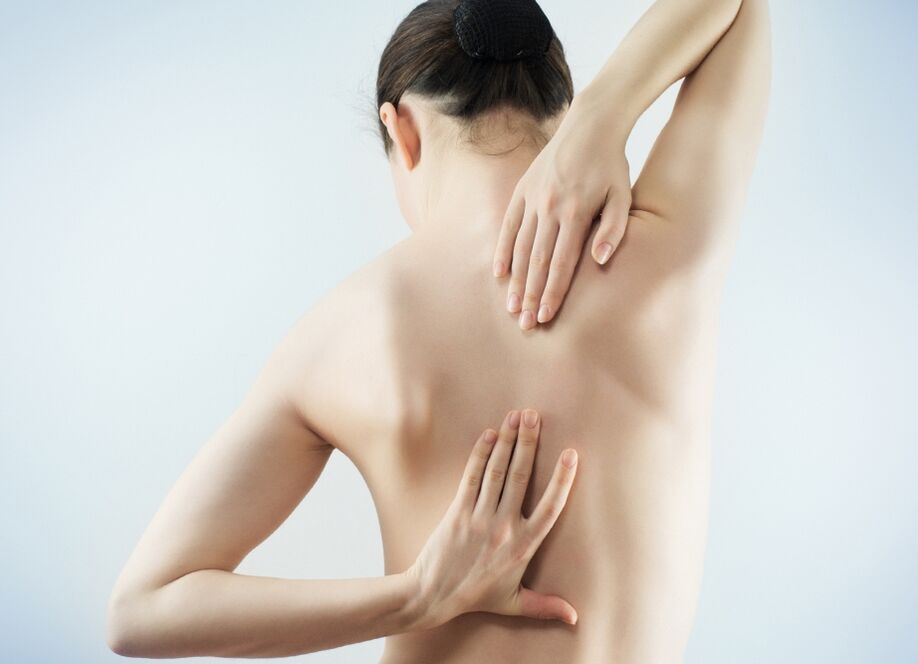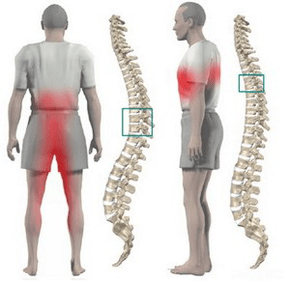
Osteochondrosis of the chest often affects the organs associated with areas of the spinal cord that are located at the level of and below the damaged region of the chest. Disruption of the normal activity of the spine leads to immobility of the arms, legs and the whole body, dysfunction of the pelvic organs, respiratory muscles and internal organs.
Osteochondrosis is a degenerative-dystrophic disease of the spine, which is based on the change of the intervertebral discs with the involvement of the neighboring spine and intervertebral joints in the pathological process along with the entire ligament apparatus.
Peculiarities of spinal anatomy
The mobility and stability of the spinal column, elasticity and resilience largely depend on the intervertebral discs, which are one of the types of cartilaginous connection between the bones and provide a strong connection between the bodies of the neighboring vertebrae. The total length of the intervertebral discs is a quarter of the length of the spinal column.
The most important function of the discs is to reduce the vertical load on the spine. The disc consists of three parts:
- Hyaline plates (closely adjacent to vertebrates);
- nucleus pulposus (fills the gap between the plates);
- Fiber ring (surrounds the core from the outside).
The nucleus contains cartilage cells, tightly intertwined collagen fibers, and chondrin (proteoglycans). The anterior surface of the discs is covered by the anterior longitudinal ligament, which is tightly fused to the vertebrae and glides freely on the discs. The posterior longitudinal ligament is firmly fused to the surface of the disc and forms the anterior wall of the spinal canal. The intervertebral disc does not have its own blood supply, so it feeds on substances that come from the vertebral bodies by diffusion.
The distribution of vertical loads in the spinal column occurs due to the elastic properties of the discs. As a result of the pressure, the pulp nucleus expands and the pressure is redistributed to the fibrous and hyaline plates of the annulus. During the movement, the nucleus moves in the opposite direction: during flexibility - towards the convex, when lifting - at the front. When the spine moves, muscles, ligaments, and discs come into play. Hence, a disorder in one ring leads to a disorder in the entire kinetic chain.
Causes and mechanism of disease development
Mechanical action on the spine plays a special role in the development of osteochondrosis. Under the influence of unfavorable static and dynamic loads, the pulp nucleus gradually loses its elastic properties (as a result of depolymerization of polysaccharides), forming protrusions and sequesters.
The process of disc degeneration is influenced by genetic predisposition, which leads to the development of changes in the spinal neuromuscular apparatus, changes in the structure of glucosamines, and disruption of the distribution of collagen fibers in the disc. A genetic factor is crucial in the development of thoracic osteochondrosis, which is subject to increased functional activity.
Risk factors for the development of degenerative changes in the spine include the anatomical features of the discs, which are imperfect of evolution. One such feature is the nutritional characteristics of the structures. The disc in the human body is made up of poorly soaked tissue. Closure of blood vessels occurs already in childhood. After feeding occurs due to diffusion of substances into the last plates.
Nutrient load stimulator is a dosed load that eliminates static postures and great stress. Physical inactivity is one of the leading risk factors for osteochondrosis of the chest. Therefore, regular exercise is an important preventative measure.
The peculiarity of the microscopic structure - a few cells - reduces the intensity of regenerative ability and the speed of recovery of disk components. The anatomical feature is the weakness of the discs and the lack of strength in the rear sections. This promotes the appearance of wedge-shaped discs in the lower chest and lumbar region.
Involutionary changes are of great importance in the development of osteochondrosis. Actively degenerative changes begin to increase after 30 years. The synthesis of the components necessary for the disc (glycosaminoglycans) continues, but their quality deteriorates. Hydrophilicity decreases, fibrosis increases, sclerosis occurs.
Stages of degeneration of intervertebral discs:
- Prolonged asymptomatic current, degenerative changes in intradiscal components, movement of the nucleus within the disc;
- Pronounced radicular symptoms of thoracic osteochondrosis, spinal cord compression, protrusion of the pulp nucleus (protrusion, 1 degree);
- Disc herniation with hernia rash (hernia, 2nd degree);
- Degenerative changes in extradiscal components (grade 3).

Abnormal protrusion compresses nerve roots, blood vessels, or the spinal cord at different levels (cervix, chest, lumbar region), which determines the clinical picture.
Restriction of mobility of the thoracic spine due to the presence of the thorax contributes to less trauma to the intervertebral discs and, consequently, osteochondrosis. Physiological chest kyphosis promotes the distribution of weight in the upper half of the body to the lateral and anterior parts of the spine. Therefore, intervertebral hernias and osteophytes form on the anterior and lateral surfaces of the spine. Posterior osteophytes and hernias are very rare.
Osteochondrosis contributes to the narrowing of the intervertebral foramen and the compression of the roots of the spinal cord and sympathetic fibers. Sympathetic fibers are produced in the gray matter of the spinal cord, then accumulate in the nodes from where they are sent to all internal organs. This leads to the fact that osteochondrosis of the chest, in addition to typical neurological disorders, causes dysfunction of internal organs (vegetative, vasomotor, trophic) and imitation of somatic diseases. This feature of osteochondrosis of the thoracic discs explains the difficulties in diagnosing and prescribing the correct treatment.
Symptoms of Chest Osteochondrosis
Chest osteochondrosis is more common in people with sedentary lifestyles. At the same time, there is no stimulating effect of dosed loads on the spine, which contributes to the disruption of disc recovery. Diseases develop in people who work long hours at the computer, lean, and so on. Sh. Such people need to perform therapeutic exercises independently.
Most often chest osteochondrosis is manifested by dull pain, less often it hurts and burns. The pain is localized between the shoulder blades. The patient suffers from a feeling of tightness in the chest. Sensation of vertebral processes in the thoracic spine reveals local pain that increases with axial loading on the spine, deep inspiration, and body curves.
Some patients experience sharp pain in the lower back and chest (posterior costal syndrome). These symptoms develop as a result of displacement of the lower ribs. The pain increases sharply when the body rotates. More often the pain syndrome disappears suddenly.
Often the pain in the chest area becomes a belt, corresponding to the flow of the intercostal nerve. Sensitivity in the innervation zone of the corresponding nerve endings is disturbed, paresthesia occurs, often superficial and deep sensitivity is observed. Possible dysfunction of the abdominal press, altered knee and calcaneus reflexes.
Impairment of internal organs occurs when any of the nerve roots is compressed at levels 1 to 12 of the chest. There are structures in the chest that are responsible for innervating the lungs, heart, intestines, liver, pancreas, and kidneys. Therefore, there are no characteristic signs only for thoracic osteochondrosis.
The disease is manifested by symptoms characteristic of other pathologies:
- Difficulty breathing;
- Strong night pains;
- "Heart", angina pectoris;
- Pain in the mammary glands;
- Pain in the right or left hypochondrium (symptoms of cholecystitis and pancreatitis);
- Pain in the throat and esophagus;
- Pain in the epigastrium, abdomen (symptoms of gastritis, enteritis and colitis);
- Sexual dysfunction.
Diagnosis
X-ray examination of the chest is of the greatest importance in the diagnosis of thoracic osteochondrosis. The picture shows a decrease in the height of the intervertebral disc, sclerosis of the last plates, the formation of osteophytes.
Computed tomography allows you to determine the condition of the spine, vertebral joints, the size of the spinal canal, determine the location of the hernia rash and its size.
When making a differential diagnosis it is necessary to carefully collect a medical history and compare all the clinical signs of chest osteochondrosis with the symptoms of other diseases. For example: in osteochondrosis the pain in the heart is not stopped by nitroglycerin, the epigastric pain is not related to food intake, it is not seasonal, all the symptoms are manifested mainly in the evening and disappear completely after a night's rest.
How to treat chest osteochondrosis?
Treatment of thoracic spine osteochondrosis is conservative in almost all cases. The indication for therapy is the predominance of visceral syndromes with neurological disorders. The main orthopedic treatment should be adequate traction of the spine:
- Active vertical traction under water;
- Passive horizontal traction in a reclining bed using a Gleason loop in case of injury to 1-4 thoracic vertebrae, in case of 4-12 thoracic vertebral injury.
Drug treatment involves performing paravertebral blockades with novocaine solution. Analgesics and sedatives are used to aggravate the disease. In case of pronounced pain syndrome it is permissible to use ointments with analgesics and anti-inflammatory agents at home.
After eliminating the acute phenomena, massage the muscles of the back and lower extremities. Manual therapy is indicated for the development of functional blockades at 1-3 degrees of osteochondrosis. It includes various options for soft and rough effects on the spinal muscles.
Therapeutic exercise allows you to load all parts of the spine in a dosed manner, which stimulates the recovery process. An important condition for exercise therapy for osteochondrosis is the exclusion of vertical loads.
Physiotherapy: UHF treatment, ultrasound, inductotherm, radon and pine-coniferous salt baths. Underwater traction and hydromassage are actively used in the spa stage.
Surgical treatment is rarely used. Indication of surgical intervention is compression of the spinal cord with a prolapsed disc fragment.

















































